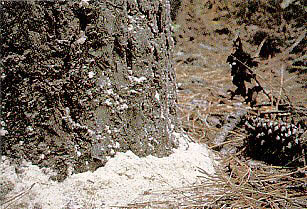Ambrosia beetles
Natural History

Dust from beetle tunnels piled at base of tree
Photo credit: USDA Forest Service
"Ambrosia beetles" is the common name used collectively for a group of wood-boring insects in a number of related genera. These insects, which are found throughout the southern United States, share a common habit of tunneling through the bark into the wood of trees. Ambrosia beetles may cause significant damage to green logs and unseasoned lumber, and occasionally to dead, dying, or severely stressed trees.
As the adult beetle chews through the bark and into the wood, it creates a series of winding tunnels called "galleries." The wood debris from the galleries can appear as either a series of thin, white tubes pushed out of the bark or as fine sawdust piling up at the base of the tree. The insect does not use the tree xylem as food, but uses the galleries that are created as a place for a fungus to grow. The fungus becomes the source of food for the insects. Interestingly, because of this dependence on the fungus, the insect carries spores of the fungus with it as it moves from one tree to another. This transportation of spores guarantees that, no matter where the ambrosia beetle may go, it will always be able to produce a steady food supply.
Here in the southeastern United States, the redbay ambrosia beetle (Xyleborus glabratus) is a species of special concern because it transmits the fungus that causes laurel wilt disease. The disease primarily affects redbay (Persea borbonia) but it can also damage or kill other members of the laurel family, including avocado. The redbay ambrosia beetle is not directly responsible for the widespread death of redbay trees, but by transporting the fungus from tree to tree it is the vector that allows the disease to spread.
